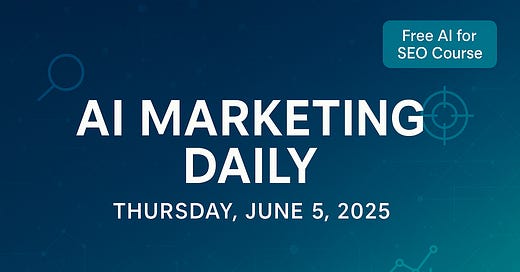Yesterday's developments reveal critical shifts in AI-powered search optimisation, with Google's indexing requirements tightening and new evidence showing AI now dominates both content creation and campaign management workflows.
Story #1: Google Confirms Indexing No Longer Guarantees AI Search Visibility
Source: Search Engine Land (published June 4, 2025)
URL: https://searchengineland.com/ (Barry Schwartz, Jun 4, 2025 at 9:38 am ET)
What Happened: Barry Schwartz reported that Google has confirmed being indexed does not guarantee your pages will show within AI-powered search results. This represents a fundamental shift where traditional search visibility metrics no longer apply to AI Overviews and AI Mode experiences.
Why It Matters: With AI Overviews now appearing in over 13% of searches and growing rapidly, marketers risk losing significant organic reach if their content isn't specifically optimised for AI consumption. Traditional SEO success no longer translates to AI search visibility.
Suggested Actions:
Audit your website's structure and markup to ensure AI systems can properly parse your content
Implement comprehensive schema markup specifically designed for AI understanding
Story #2: Structured Content Essential for AI Search Recommendations
Source: Search Engine Land (published June 4, 2025)
URL: https://searchengineland.com/ (Will Scott, Jun 4, 2025 at 9:00 am ET)
What Happened: Will Scott's analysis emphasises that if AI can't read your website, it won't recommend it. The article provides guidance on how to structure and mark up content to win in the age of AI-powered search, highlighting specific technical requirements for AI visibility.
Why It Matters: This isn't just about being found anymore—it's about being understood and recommended by AI systems. Poor content structure now means complete invisibility in the fastest-growing segment of search results.
Suggested Actions:
Review your content hierarchy and heading structure for AI readability
Implement the technical markup recommendations outlined in Scott's analysis
Story #3: Google Ads In-Market Segments Expand with New Limitations Guidance
Source: Search Engine Land (published June 4, 2025)
URL: https://searchengineland.com/ (Jyll Saskin Gales, Jun 4, 2025 at 11:05 am ET)
What Happened: Jyll Saskin Gales detailed which campaign types now support Google Ads' in-market segments, including guidance on addressing niches that aren't covered and understanding the limitations of this targeting method.
Why It Matters: As third-party cookies disappear, in-market segments provide crucial privacy-compliant targeting capabilities. The expansion across more campaign types offers new opportunities for precise audience targeting without relying on invasive tracking methods.
Suggested Actions:
Review which of your campaigns can now leverage in-market segments
Test in-market targeting against your current audience strategies to measure performance improvements
Story #4: Double-Serving Update Distorts Auction Insights Accuracy
Source: Search Engine Land (published June 4, 2025)
URL: https://searchengineland.com/ (Adthena, Jun 4, 2025 at 7:00 am ET)
What Happened: Adthena's analysis reveals that Google's update allowing double-serving is distorting impression share metrics, making Auction Insights potentially unreliable for competitive analysis and strategic planning.
Why It Matters: Accurate competitive intelligence is essential for strategic advertising decisions. With potentially skewed data in Auction Insights, marketers may make incorrect assumptions about competitor strategies and market dynamics.
Suggested Actions:
Cross-reference Auction Insights data with alternative competitive intelligence tools
Adjust your competitive analysis methodology to account for double-serving impacts
Story #5: AI Marketing Tools Hit 88% Daily Usage Among Professionals
Source: CoSchedule State of AI in Marketing Report 2025 (published June 4, 2025)
URL: https://coschedule.com/ai-marketing-statistics
What Happened: New research reveals that 88% of marketers now use AI in their daily roles, with 39.4% of companies being "very open" to AI adoption. The study shows AI-generated content outperforming traditional content in 25.6% of cases, whilst 41.65% of marketing tools now include AI features.
Why It Matters: AI has moved from experimental to essential, with the majority of marketing professionals now relying on AI tools for content creation, optimisation, and campaign management. Companies not adopting AI risk significant competitive disadvantage.
Suggested Actions:
Benchmark your current AI tool usage against the 88% industry standard
Develop a systematic AI implementation strategy focusing on proven use cases
Story #6: SOPs Become Critical for Small SEO Operations in AI Era
Source: Search Engine Land (published June 4, 2025)
URL: https://searchengineland.com/ (Claire Taylor, Jun 4, 2025 at 8:00 am ET)
What Happened: Claire Taylor's analysis demonstrates that standard operating procedures aren't just for large teams anymore. Small SEO operations need streamlined systems to remain competitive as AI tools become prevalent in SEO workflows.
Why It Matters: As AI automates routine SEO tasks, human oversight becomes more crucial, not less. Small teams with well-defined SOPs can compete effectively with larger operations by leveraging AI tools whilst maintaining consistent quality standards.
Suggested Actions:
Document your current SEO processes and identify areas where SOPs can improve consistency
Create AI tool usage guidelines integrated into your standard operating procedures
Comprehensive Analysis: The New Reality of AI-Integrated Marketing Operations
Wednesday's developments collectively demonstrate that the marketing industry has crossed a critical threshold. We're no longer discussing AI adoption—we're witnessing the emergence of AI-dependent operational models that fundamentally reshape competitive dynamics.
Google's confirmation that indexing doesn't guarantee AI search visibility represents perhaps the most significant SEO paradigm shift since mobile-first indexing. Combined with the technical requirements outlined by Will Scott, it's clear that traditional SEO strategies require complete recalibration for AI-powered search environments.
The expansion of in-market segments, alongside the double-serving complications affecting Auction Insights, illustrates Google's push towards more sophisticated, AI-integrated advertising approaches. Marketers must navigate increasingly complex targeting capabilities whilst dealing with potentially unreliable competitive intelligence data.
Most telling is the CoSchedule research showing 88% daily AI usage among marketers. This isn't gradual adoption—it's wholesale operational transformation. The fact that AI-generated content outperforms traditional content in over a quarter of cases demonstrates tangible competitive advantages for early adopters.
Claire Taylor's emphasis on SOPs for small teams reveals a crucial insight: as AI handles routine tasks, process management becomes the key differentiator. Success in this new environment depends not on AI adoption speed, but on implementation quality and systematic integration.
The evidence suggests we've entered a bifurcated market where AI-integrated operations significantly outperform traditional approaches. Marketing leaders must move beyond experimentation to systematic AI integration or risk being fundamentally disadvantaged.
Key Takeaways:
AI search visibility requires new technical standards: Traditional indexing success no longer translates to AI search visibility—content must be specifically structured for AI consumption.
Competitive intelligence accuracy is compromised: Double-serving updates are affecting Auction Insights reliability, requiring alternative analysis methods.
AI adoption has become operationally essential: With 88% daily usage rates, competitive advantage now lies in implementation quality rather than adoption speed.
Process management trumps tool adoption: Well-defined SOPs are essential for leveraging AI tools effectively whilst maintaining quality standards.
How-To Spotlight: Building AI-Ready Content Architecture
Based on Will Scott's technical guidance and Barry Schwartz's indexing insights, here's a systematic approach to preparing your content for AI search visibility:
Implement semantic markup: Use comprehensive schema.org markup including Article, FAQ, How-To, and relevant business schemas to help AI systems understand content context.
Structure content hierarchically: Create clear information architecture with logical heading sequences (H1→H2→H3) that AI systems can easily parse and understand.
Optimise for AI comprehension: Write topic sentences that explicitly state the main point, use clear transitions between ideas, and include summary statements that AI systems can extract.
Create answer-focused content: Structure content to directly answer specific questions, as AI systems often extract information from well-formatted, direct responses.
Test AI readability: Use available tools to verify that your content can be properly parsed and understood by AI systems before publication.
FREE BETA ACCESS: We've launched our AI for SEO course to help you implement these cutting-edge strategies. Get free access during the beta period at https://seoaicourse.indexify.co/
COMING SOON: We're also developing a more advanced course for marketers who want to take their AI skills to the next level. Check out our LinkedIn announcement for early details.
Subscribe to our daily updates: https://indexify.substack.com/ and listen to our podcast: https://indexify.substack.com/podcast














Share this post